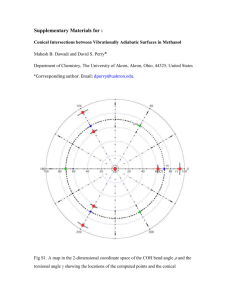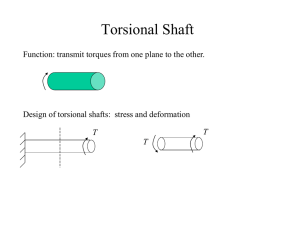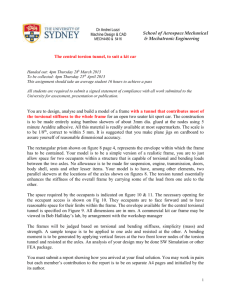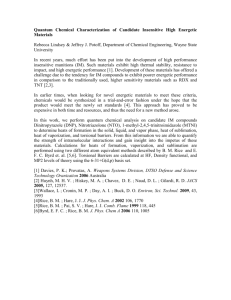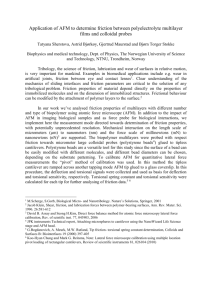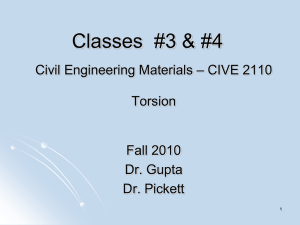torsional model and analytical simulation for complex rotating
advertisement
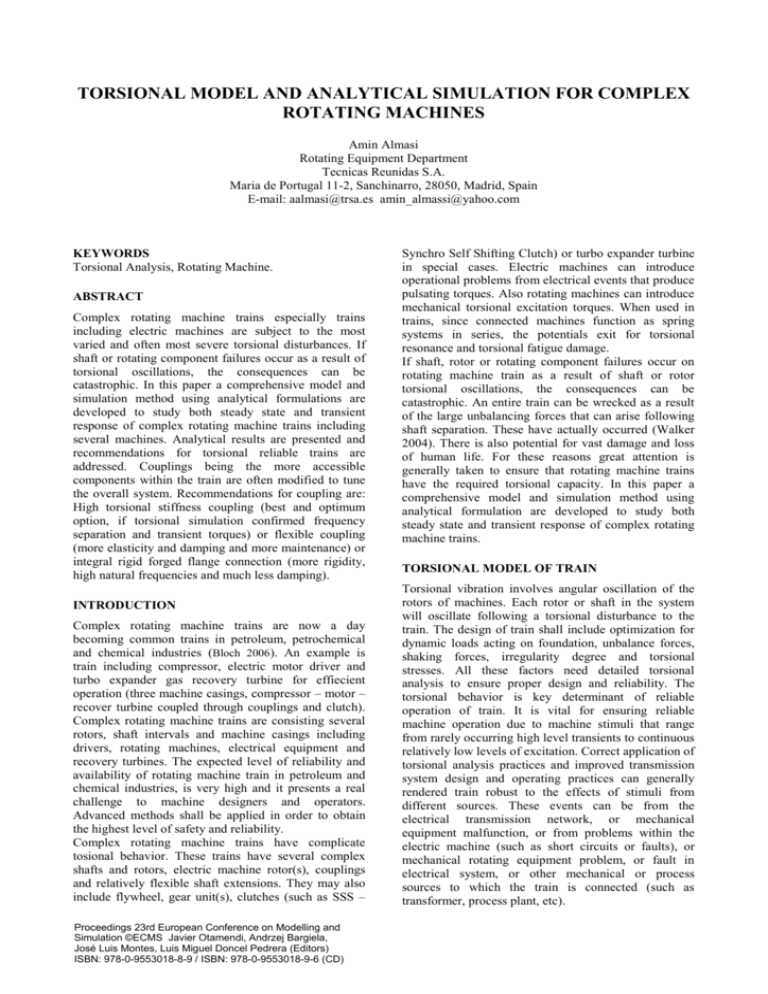
TORSIONAL MODEL AND ANALYTICAL SIMULATION FOR COMPLEX ROTATING MACHINES Amin Almasi Rotating Equipment Department Tecnicas Reunidas S.A. Maria de Portugal 11-2, Sanchinarro, 28050, Madrid, Spain E-mail: aalmasi@trsa.es amin_almassi@yahoo.com KEYWORDS Torsional Analysis, Rotating Machine. ABSTRACT Complex rotating machine trains especially trains including electric machines are subject to the most varied and often most severe torsional disturbances. If shaft or rotating component failures occur as a result of torsional oscillations, the consequences can be catastrophic. In this paper a comprehensive model and simulation method using analytical formulations are developed to study both steady state and transient response of complex rotating machine trains including several machines. Analytical results are presented and recommendations for torsional reliable trains are addressed. Couplings being the more accessible components within the train are often modified to tune the overall system. Recommendations for coupling are: High torsional stiffness coupling (best and optimum option, if torsional simulation confirmed frequency separation and transient torques) or flexible coupling (more elasticity and damping and more maintenance) or integral rigid forged flange connection (more rigidity, high natural frequencies and much less damping). INTRODUCTION Complex rotating machine trains are now a day becoming common trains in petroleum, petrochemical and chemical industries (Bloch 2006). An example is train including compressor, electric motor driver and turbo expander gas recovery turbine for effiecient operation (three machine casings, compressor – motor – recover turbine coupled through couplings and clutch). Complex rotating machine trains are consisting several rotors, shaft intervals and machine casings including drivers, rotating machines, electrical equipment and recovery turbines. The expected level of reliability and availability of rotating machine train in petroleum and chemical industries, is very high and it presents a real challenge to machine designers and operators. Advanced methods shall be applied in order to obtain the highest level of safety and reliability. Complex rotating machine trains have complicate tosional behavior. These trains have several complex shafts and rotors, electric machine rotor(s), couplings and relatively flexible shaft extensions. They may also include flywheel, gear unit(s), clutches (such as SSS – Proceedings 23rd European Conference on Modelling and Simulation ©ECMS Javier Otamendi, Andrzej Bargiela, José Luis Montes, Luis Miguel Doncel Pedrera (Editors) ISBN: 978-0-9553018-8-9 / ISBN: 978-0-9553018-9-6 (CD) Synchro Self Shifting Clutch) or turbo expander turbine in special cases. Electric machines can introduce operational problems from electrical events that produce pulsating torques. Also rotating machines can introduce mechanical torsional excitation torques. When used in trains, since connected machines function as spring systems in series, the potentials exit for torsional resonance and torsional fatigue damage. If shaft, rotor or rotating component failures occur on rotating machine train as a result of shaft or rotor torsional oscillations, the consequences can be catastrophic. An entire train can be wrecked as a result of the large unbalancing forces that can arise following shaft separation. These have actually occurred (Walker 2004). There is also potential for vast damage and loss of human life. For these reasons great attention is generally taken to ensure that rotating machine trains have the required torsional capacity. In this paper a comprehensive model and simulation method using analytical formulation are developed to study both steady state and transient response of complex rotating machine trains. TORSIONAL MODEL OF TRAIN Torsional vibration involves angular oscillation of the rotors of machines. Each rotor or shaft in the system will oscillate following a torsional disturbance to the train. The design of train shall include optimization for dynamic loads acting on foundation, unbalance forces, shaking forces, irregularity degree and torsional stresses. All these factors need detailed torsional analysis to ensure proper design and reliability. The torsional behavior is key determinant of reliable operation of train. It is vital for ensuring reliable machine operation due to machine stimuli that range from rarely occurring high level transients to continuous relatively low levels of excitation. Correct application of torsional analysis practices and improved transmission system design and operating practices can generally rendered train robust to the effects of stimuli from different sources. These events can be from the electrical transmission network, or mechanical equipment malfunction, or from problems within the electric machine (such as short circuits or faults), or mechanical rotating equipment problem, or fault in electrical system, or other mechanical or process sources to which the train is connected (such as transformer, process plant, etc). It is of paramount importance to avoid torsional resonance (particularly at or near the lower harmonics of train operating speed frequency), and to ensure that shafts and other components are suitably sized to avoid failure or significant damage during possible sever transient disturbances. The procedure for torsoinal analysis and simulation include following steps. Modeling of train, calculation of undamped natural frequencies, harmonic components calculation and forced vibration calculation. The model must be accurate enough to simulate the real system behavior at least for frequencies below the 20th multiple of the maximum rotating speed. Only a model with enough details and large number of elements make it possible to evaluate higher number of vibration modes. In the other hand very high frequency additional modes ( such as frequencies more than 20th multiple of the maximum rotating speed) has no effect since no resonance is foreseen and they are related to low amplitude exciting harmonics (Giacomelli et al. 2006). Basically the model is represented by a number of rotating masses connected to each other by means of mass-less shaft intervals with appropriate torsional stiffnesses. Rotating masses can represent both the rotor or shaft intervals and the connected components to each interval. The mass elastic model of rotor or shaft is created by lumping the inertia. Generally rotor or shaft between two bearings can be modeled as single masselastic element. However for complicated and complex intervals which include many details and components more sophidticated model including several mass-elastic element shall be used. The coupling is modeled as a single torsional spring (coupling sub-vendor supplied torsional stiffness) with the inertia of the associated coupling halves at each end. These inertias are added to the rotating machine shaft model masses in both sides of coupling. Proper dedicated lumped masses for all accessories (such as flywheel, gear wheel, exciter, connecting flange, etc) shall also be added to model. Model and formulation parameters are as follows: θi Torsional displacement of mass i (rad). Ji Polar moment of inertia of mass i (kg s3/m). Torsional stiffness of the shaft internal i (N m). Ki Ci Damping coefficient for interval i (kg s2/m). CMi Damping coefficient for the mass i (kg s2/m). n Model lumped mass total number. m Maximum machine torque harmonic order. ω Torsional natural frequency (rad/s). Mi Applied torque to mass i (N m). NATURAL FREQUENCIES OF TRAIN The next step is calculation of the train undamped torsional natural frequencies. The goal is to locate natural frequencies away (usually by 10%) from potential excitation frequencies that might come from both the rotating and electric machines (Rangwala 2006; Brown 2005). In addition, it is recommended that natural frequencies be placed 10% outside of electrical net frequency and 5% outside of its second multiple (Walker 2004). Natural torional frequencies reach higher values as their order increases and in practice the first three modes of vibration usually need to be investigated in detail. Torsional natural frequencies come from solution of Equations (1). The calculation of the undamped natural frequencies is a problem of eigenvalues and eigenvectors which represent natural frequencies and mode shapes respectively. J 1θ1 + K1 (θ1 − θ 2 ) = 0 J iθi + K i −1 (θ i − θ i −1 ) + K i (θ i−θ i +1 ) = 0 , i = 2,..., n − 1 J θ + K (θ − θ ) = 0 n n n −1 n (1) n −1 Generally most rotating equipment and electrical machine have a low level of torsional damping (Walker 2004; Giacomelli et al. 2006). It is found that the amount of torsional damping in turbomachinery is very low unless special provisions are made. For heavy duty machines, it is impractical and uneconomical to employ mechanical damping devices to substantially reduced peak vibration response levels following severe torsional vibration (Walker 2004). Because of low damping level, undamped natural frequencies can represent natural frequencies of real train (Giacomelli et al. 2006). Observations are in agreement with this assumption. The torsional mechanical response will generally be multimodal with a slow decay rate because of the light damping (Walker 2004; Giacomelli et al. 2006). The main concern is for first torsional natural frequency position because higher natural frequency orders are associated with high harmonics which have little effects. In case the torsional natural frequencies do not meet mentioned margins (10% away from potential excitation frequencies), individual train component can be modified. Parametric study of presented natural frequency calculation method can provide information on how to tune rotating machines train, if natural frequency separation margins are discovered to be unacceptable for reliable performance. Modification of coupling torsional stiffness by an appropriate tuning of the coupling type or space diameter is primary and easiest solution. Generally the coupling is the most flexible shaft interval in train and has a strong influence on first torsional natural frequency. Range of available coupling options is vast. From flexible coupling to rigid forged flanged connection (without coupling). However If coupling modification is not sufficient and further modification is required (mainly in case of more torsional stiffness required to raise first torsional natural frequency) modification of electric machine shaft geometry (mostly diameter) can be studied jointly with electric machine sub-vendor. The modification of rotating machine (process critical compressor, heavy duty steam or gas turbine, etc) rotor or crankshaft geometry is very difficult and in most cases it is never modified to accommodate torsional application requirements. DAMPED STEADY STATE TORSIONAL RESPONSE If there is interference between torsional natural frequencies and excitation harmonics and modification is not desired or possible, it is necessary to make torsional stress analysis. Stress analysis shall be performed to ensure that the resonance will not be harmful for the train. First step is steady state torsional analysis. The analysis should be performed for all possible operating conditions including all possible speeds and capacities. The governing equations of system to calculate the damped forced torsional vibration are as Equation (2). ( ) J 1θ1 + K1 (θ1 − θ 2 ) + C1 θ1 − θ2 + C M 1θ1 = M 1 J θ + K (θ − θ ) + K (θ −θ ) + C θ − θ i i ( i −1 i ) i −1 i i +1 i i −1 ( i i −1 ) (2) + Ci θi − θi +1 + C Miθi = M i , i = 2,..., n − 1 J nθn + K n −1 (θ n − θ n −1 ) + Cn −1 θn − θn−1 + C Mnθn = M n ( ) The general expression of the steady state applied torques (Mi) includes a vibrating component superimposed on an average torque level as per Equation (3). Train load torques can be decomposed, through a ''Fourier'' analysis, into series of sinusoidal curves which frequencies are multiple of machine running speed and modulus generally decreases as the harmonic order increases. The higher the number of harmonics considered, the closer the results to real torque. Optimum solution suggested as calculation of 25 harmonics (m=1 to 25). m M i = ∑ M i , p sin ( pωt + α p ) (3) p =0 The torsional dampening is assumed to be the hysteretic (Harris and Allan 2002; Giacomelli et al. 2006). Each applied torque must be properly phased with respect to relatively train rotor angular position. The electric machine torque supposed to be constant during steady state load however there are relatively small fluctuating torques components due to interactions between the current pulsation of electrical elements (such as winding) and electrical machine shaft mechanical irregularity degree. These fluctuations generally can be neglected for steady state response. Solution of Equation (2) can be obtained based on ''Principle of Linear Superposition''. The system is composed of (n) linear differential equations with (n) parameters, tridiagonal and symmetrical. Its solution can be transferred to the solution of (m) differential equation system (each equation related to different harmonic of the exciting forces). A sensitively analysis should be always carried out to take into account all possible variances affecting the model especially those due to fluctuations of running speed (such as net frequencies, etc) which can shift the harmonics of the running speed. Variations of the mass elastic data (i.e. coupling stiffness, rotor inertia, etc) can shift the torsional natural frequencies. Alternative option of considering the relative position of the harmonics and natural frequencies, is to calculate the torques and stresses over a range of 10% of the rated speed. The highest values within that range can be comparable to correspondence endurance limit for torsional fatigue. For a train, torsional stress is function of related position of torsional natural frequencies and exciting harmonics. TRANSIENT TORSIONAL RESPONSE There are usually many cases of transient disturbances which should be modeled. The transient torsional analysis requires a different and more time consuming calculation method since it requires a direct integration of the motion equations. In this case the solution is time dependent. The differential equations of motions are similar to those of the steady state as Equation (2), but they have different exciting torques. In this case rotating machine torques (Mi) components shall be obtained. Inertia and fluid transient torque components shall be separately calculated. Train speed variations affect the inertia transient torque components and fluid transient torque contributions in different manner. For some rotating machines (such as positive displacement machines) fluid transient torque components can be assumed without considerable changes when speed changes. However electric machine torque excitation is not periodic. As result, in general, train transient torque excitations can not be given in ''Fourier Series''. The transient analysis out put is generally represents by torque and stress plots for each rotor as a function of time. However the main results of the transient analysis can be given in terms of peak shear stress in machines and peak torque on couplings. The highest stress / torque amplitudes acting on rotating equipment, electric machine and coupling shall be compared to the endurance limits of each of the respective components. In case the torques and stresses are not within the allowable endurance limits, a redesign must be carried out in order to achieve a wider separation margin between torsional natural vibration frequencies and high amplitude harmonics to obtain lower stresses. The fact that the damping of the train is low can lead to the generation of extremely high transient torques in train shafts as a result of response compounding if torsional disturbances occur in rapid succession. The resulted alternating stresses in the train shafts and other components need to be below the fatigue endurance limit of the material involved. This is because of the very high number of stress cycles that will be experienced over the life of the machine as the cycles are being accumulated continuously. ELECTRICAL EFFECTS ON COMPLEX TRAIN It is most important to study problems from electrical events that can produce pulsating torques and torsional vibration in complex rotating machine train. There are wide varieties of incidents that can cause electrical current oscillations in the electrical transmission to which the electric machine is connected. In each case, the incident results in an oscillating torque applied to the train, which can stimulate twisting oscillations in the machine shafts and vibration of various rotating and non rotating components. Electrical transient disturbance can be planned or unplanned (emergency) transmission line switch incidence, electrical faults in the transmission network such as electrical circuit breaker actions or fault caused by storms, electric machine internal faults or terminal short circuits. In case of power generation (rotating machine coupled to electric generator) transient disturbance can be mal-synchronization of the generator to the electrical network. These transient oscillations generally include a step change in torque (impulse) and discrete frequency torque components at the first or second harmonics of the power system frequency, with generally low levels at the higher harmonics. The step change torque component decays quite slowly (order of seconds) however the lower harmonics of the power system frequency decay rapidly in comparison (order of tenth of seconds). An example of this is with the use of some forms of high speed reclosing of electric transmission line circuit breakers following the electrical faults in network. As discussed electrical line fault can result from either temporary or permanent electrical transients (for example electrical lighting strike, transmission line break, a tree fall into a transmission line causing long term transmission line phase to phase or phase to ground fault, etc ). Following any type of electrical fault in the transmission line with one form of high speed reclosing, the power circuit breakers automatically open after a few electrical cycles (1/50 of seconds) to isolate the fault and then automatically reclose after only several tenths of second. If the fault has cleared during this period then no significant shaft torque compound occurs. However high percentage of severe multiphase faults are permanent and thus may not benefit from high speed reclosing. In case of permanent fault then a second major torsional event will be experienced by the magnitude approximately equal to that of the first one. As the damping of the torsional modes is very light the response amplitudes in the shafts from the first electrical disturbance will be decayed only slightly when the circuit breakers reclose into the fault for the second time. If the timing of this reclosure is at its most unfavorable, the shaft torques could approximately double as a result of response compounding . There is potential for torsional insatiability on trains connected to electrical networks that have series capacitor compensated lines to reduce power transmission losses (sub-synchronous resonance or SSR). Machines connected to direct current transmission lines can also be affected with instability in this case due, for example, to incorrect operation or mal-adjustment of rectifier and inverter control equipment. In such these cases, torque pulsations are produced by electric machine due to current pulsation and magnetic fields interactions. In general these torque pulsations do not cause any harm unless their frequency (resistance, inductance and capacitance circuit introduces an electrical resonance frequency) coincides with, or is close to, one of the torsoinal natural frequencies of the train. Under these conditions the shaft response torque could build up to extremely high level. Recommended corrective actions for SSR problem included installation of large filters to remove the harmful current frequency components from entering the electric machine, installing electrical damping devices, and addition of protective monitoring and relaying equipment (Walker 2004). The rectifiers, inverters, high voltage direct current (HVDC) transmission system or large nonlinear electrical systems feed significant harmonics of the fundamental power frequency into electrical network. Train is subjected to significant high order harmonic currents entering the armature of the electric machine which produce pulsating torques on the rotor, causing torsional vibration. These pulsating torques are at (6n) harmonic frequencies (6, 12, 18, etc) and would be of concern only if they become resonant with a train torsional natural frequencies. The lowest harmonic torque frequency and the one that generally has the highest amplitude is the sixth harmonic. Higher order harmonic torques are therefore rarely of concern (Walker 2004). Certain harmonic effects arise when an electric machine is started. Usually the main concern is with torque dips in induction motors, which affect motor's ability to reach full speed. But there are some effects that can result in torque pulsations. These are due to interactions between various sources of harmonics in machine magnetomotive forces and fluxes. The main sources of harmonics are distribution nature of the stator winding, distribution nature of rotor currents, slotting on the stator (or rotor) which produces a permanent variation at slot pitch frequency and pulsation of main flux because the average permeance of the air gap fluctuates as the rotor moves relative to the stator. The interaction between all these different harmonic sources can produce torques that rise and fall with speed, sometimes accelerating the shaft, sometimes slowing down the shaft. Torque pulsation frequency will vary as the machine speed changes. These torques and their magnitudes depend on the relative number of stator and rotor slots, the use of open and closed slots, the rotor slot skew, and the electric machine reactance and resistances. There have been reported cases (Walker 2004) of torques large enough to cause damages. IRREGULARITY IN COMPLEX TRAINS For some rotating machine trains ( such as reciprocating trains), flywheel is mandatory to regulate variable train torques. Irregularity degree for mechanical component reliable operation is maximum 2%. This value is minimum requirement for all trains. Generally in accordance with specific requirements of electric network, electric machine (especially current pulsation), rotating equipment, operation, torsional vibration results, train complexity, etc, lower irregularity value is required. It is recommended to obtain 1% for special purpose units in petroleum and petrochemical plants. Irregularity values between 1-1.5% are in common use. VARIABLE SPEED COMPLEX TRAINS Variable frequency motor drives are becoming more popular (Brown 2005). For variable speed multimachine rotating equipment trains, complex issues of torsional response and feedback due to torque pulsation shall be addressed. Because of the complexity of the train, the system is limited in its turn down by torsional problems. Torsional analysis is vital for development of relatively new technology of variable speed multi-machine complex trains. In variable frequency drive (VFD), the inverter converts the AC power to a series of DC voltages, and then varies the frequency of DC pulses to approximate a sinusoidal waveform at the desired frequency. The AC waveform produced by this process is rich in harmonics because the fast switching creates voltage spikes. This results high order harmonic torques to electric machine and consequently to complex train. During normal and transient operation and the frequency run up and run down, there are large number of potential operating speeds and hold points. There are significant risks of the development of resonant mechanical response and mechanical damage. It is important that torsional natural frequencies being calculated and modified as required to avoid resonances. In addition operational strategies include rapid acceleration through defined critical speeds and avoidance of operating hold points near critical speeds shall be carefully respected. Due to wide operating speed range, maintaining 10% margins between all possible excitation frequencies and natural frequencies is very difficult and usually impossible. For variable speed drives comprehensive torsional and stress analysis is necessary. Torque harmonics generated by variable speed drive can excite the resonance during start up, and therefore must be evaluated. In addition the ramp rate or frequency at which the variable speed drive controls the speed of the units should not coincide with torsional natural frequencies. A variable speed train may have several damaging torsional resonances within the operating speed ranges due to the machine excitation harmonics intersecting the first torsional natural frequency. With the use of soft coupling, the first tosional natural frequency can be tuned below minimum speed. In many instances this is the only way to achieve the full desired speed range. Otherwise the speed range has to be limited or certain speed bands have to be avoided. Soft coupling in variable speed train can add damping to the system. However dynamic torque should be calculated and compare with coupling limits. In addition limited soft coupling life can be a problem. High torsional stiffness coupling can reduce maintenance but large portion of speed range may be avoided. Comprehensive torsional analysis and study must be used to obtain optimum solution. SIMULATION RESULTS Analytical results are presented for a multi-throw complex (four throws and three cylinders) heavy duty reciprocating compressor coupled to electric motor driver (direct coupled eighteen (18) poles 6.5 MW induction electric motor) with variable frequency drive VSD for start up when plant is in isolated situation (disconnected from country electrical network). Four step capacity control, 0-50-75-100%, using fixed volume pocket at cylinder head end and suction valve unloaders are provided. Available coupling options are: High torsional stiffness coupling (if allowed by torsional analysis), flexible coupling or integral rigid forged flange connection with single bearing electric machine. Extensive simulations show for this train regarding natural frequency interfaces and all possible transient cases, flexible coupling is acceptable option due to more elasticity and damping effects which help to obtain acceptable frequency margins and reduce transient stresses. The fist torsional natural frequency of machine is more than seven times the train speed. This implies an adequate separation with respect to compressor exciting harmonics. Simulations show a coupling stiffness variance of about 35% would be required for the train to reach resonance. Compressor train integrity must be assessed during a three phase short circuit of the electric motor. The transient event assumed to last about 0.5 seconds. In this case the electric motor is subjected to a high frequency and high amplitude oscillating torque. Motor peak torque is around 3 times the normal value. Simulations show that torsional transient response is strongly reduced by train damping from flexible coupling selection. The peak torques and stresses are about 1.5 times their average values. Start up transient analysis is performed to obtain transient stresses during the train start up. The focus is on most critical intervals including coupling and electric machine rotor. Compressor is started unloaded and the nominal running speed is achieved within 5 seconds. Simulations show electric machine has a high frequency response at the early stage of train start. The peak stresses do not reach significant amplitudes. A local amplification occurs several second after start when the electric machine variable frequency pulsating component crosses the first torsional natural frequency. Properly accounting for abrupt diameter changes in shaft and rotors in train are important due to it can decrease stress concentration and result better system fatigue life. Figure (1) shows reciprocating compressor brake torque vs. crank angel for one revolution of crankshaft in steady state conditions. Compressor brake torques are dimensionless by rated electric motor torque. The solid and dashed-dotted curves represent compressor torque Compressor Brake Torque / Rated Electric Motor Torque for normal full load (full rated flow) and (50%) unloaded conditions (1/2 rated flow) respspectively. This figure shows how compressor brake torque varies considerably in one shaft revolution (from less than 20% of motor rated torque to around 170% of motor rated torque). It shows importance of flywheel to regulate train torque requirements and strong effects of torsional irregular torques on train torsional behavior. Different unloaded conditions show completely different torsional loading behavior. Simulations show unloaded (50%) condition represents highest irregularity in train among steady state conditions. It proves necessity to evaluate torsional behavior of all operating conditions and possible process changes. All torsional transient responses to shift from one operating condition to other shall also be modeled and analyzed. 1.8 Normal Full Load Unloaded(50%) 1.6 1.4 ELECTRIC MACHINE CONSIDERATIONS 1.2 1 0.8 0.6 0.4 0.2 0 elements can vary with temperature and torque. The actual coupling stiffness can vary by as much as 20% from catalogue values. It shows importance of sensitivity analysis especially for coupling stiffness. Also some coupling (such as coupling with rubber elements) have nonlinear stiffness which depends upon the actual transmitted torque. As system starts, the speed increase can result in a load change and consequently some of the natural frequencies will change (coupling stiffness can change and cause natural frequencies to slightly change). In these cases coupling are usually modeled linear and special attention is required for elastic data sensitivity analysis. Comprehensive torsional analysis and study, machine arrangement, all possible steady state and transient conditions, operation and maintenance must be considered for optimum coupling selection. In the other words, coupling shall be selected very carefully and with respect to torsional analysis, train arrangement and complexity, operating conditions, foreseen transient conditions and previous experiences. 0 50 100 150 200 Crank Angle(Degree) 250 300 350 Figure 1: Reciprocating Machine Brake Torque vs. Crank Angel. COUPLING SELECTION FOR COMPLEX TRAINS Many operators and vendors prefer high torsional stiffness coupling because it results to more rugged train and higher natural frequencies. Also it decreases maintenance. The soft couplings can protect the machine components by absorbing the dynamic torque generated by electrical or mechanical events. Rubber coupling usually increase maintenance since the rubber degrades over the time due to heat and environmental factors. Actual rubber coupling life may be significantly less than coupling manufacture stated life, especially if the coupling is subject to heat or harsh condition (such as oil mist, ozone, etc). Special silicon block may improve life for high temperature applications. For coupling an appropriate service factor should be used to allow for possible transient conditions. The vibratory torque and heat dissipation must be reviewed carefully. The heat dissipation is a function of the vibratory torque and frequency and is normally specified in terms of power loss (Watts). Other factors such as end float and allowable misalignment should also be addressed. The torsional stiffness of the rubber Experiences have shown that only accurate modeling and simulations of electrical machine can result to accurate torsional analysis of train. Observations show that natural frequencies of trains are sensitive to electric machine model. Flexibility and inertial distribution through the electric machine core shall be modeled accurately otherwise it can result in missed torsioal natural frequencies, inaccurate torsional analysis and torsional problems. Stiffness of electric machine shaft can be influenced by the various types of construction. Machined or welded webs can add significant stiffness (typically 10-40% more) while keyed or laminations typically add minimum stiffness. Only a detailed Finite Element Analysis (F.E.A.) of the electric machine shaft can provide accurate results. Comparisons showed more than 30% error in shaft stiffness between detailed Finite Element Analysis (F.E.A.) and simplified method (Feese and Hill 2001). Experiences have shown that some electric machines have not been designed to couple to heavy duty rotating equipment and may not be adequately sized for heavy duty complex rotating machine trains. An indication can be shaft size. Rotating machine shafts or rotors are often constructed with higher strength material and have lower strength concentration factors. As rule-of-thumb electric machine shaft diameter to be equal to or greater than the rotating machine shaft or rotor diameter. PRACTICAL RECOMMENDATIONS FOR COMPLEX TRAINS Numerous torsional vibration problems continue to occur in complex rotating machine trains. Main reasons are lack of comprehensive torsional vibration analysis and study, improper application and maintenance of coupling (mainly flexible couplings) and lack of monitoring. Shaft and rotor materials should be high strength steel. If welds are required on shaft, a weldable shaft material should be used. Proper weld procedures and material compatibility must be considered. Fabrication details (such as the electric machine pole bolt torque, etc ) should consider loads due to torsional vibration. Continuous operation at torsional resonance shall be avoided. Coupling and electric machine torsional characteristics have strong influence on train torsional vibration and can be modified to tune system. Some vendors intended to use stiff system with short flanged connection (no coupling) and single bearing electric machine. These trains have much lower damping however higher natural frequencies. These trains may be acceptable after careful review of torsional analysis including all possible operating steady state and transient torsional situations. It is important to measure and verify torsional vibration during performance test. Based on site observations, synchronous electric machine start up and short circuit cases are critical and shall be respected in details. A train which passes through a torsional natural frequency during start up may produce significant transient shaft stresses. If the system is started on a frequency basis, a start up analysis should be performed to determine if low cycle fatigue is a potential problem. As noted synchronous machines need more care for torsional analysis and they definitely need a transient torsional start up analysis. Coupling torque is usually chosen on the basis of mean requirements for full load. It must have a sufficient service factor to handle and likely overload (such as electrical faults). CONCLUSION A comprehensive model and simulation method using analytical formulations are developed to study both steady state and transient response of complex rotating machine trains. The torsional vibration analysis report shall include data used in mass elastic model, torsional natural frequencies, torsional critical speed, mode shape diagrams, interface diagrams, definition of coincidence of the excitation frequencies with the torsional natural frequencies, all possible steady state, all possible transient cases (start up, shut down cases, short circuit, electrical faults, etc ), non ideal cases, worst case design, dynamic torsional stresses (based on dynamic torque modulations, stress concentration factors, and amplification factors), comparison to determine compliance (with regard to separation margin, stresses, loading, and coupling dynamic torque) and parametric analysis to determine possible coupling modification (when separation margin, stress level or coupling torque are not acceptable). The report should also consider how the input data variance will affect the results (sensitivity analysis). REFERENCES Bloch H. P., 2006, ''Compressor and Modern Process Application'', John Wiley and Sons. Bloch H. P., 2006, ''A Practical Guide To Compressor Technology, Second Edition'', John Wiley and Sons. Brown R. N., 2005, ''Compressors Selection and Sizing'', Third Edition, Gulf Publishing. Feese T. and Hill C., 2001, ''Guidelines for Improving Reliability of Reciprocating Machinery By Avoiding Torsional Vibration Problems'', Gas Machinery Conference, Austin, Texas. Giacomelli E., Mazzali C., Campo N., Battagli P., Falciani F., 2006, ''Torsional Analysis of A-20 Cylinder Hyper Proceeding of ESDA2006, compressor Train'', Engineering System and Analysis, Torino, Italy, 4-7 July. Harris C. M., Allan G. Piersol, 2002, ''Harris Shock and Vibration Handbook'', Fifth Edition, McGraw-Hill. Rangwala A. S., 2006, ''Reciprocating Machinery Dynamics'', First Edition, New Age International (P) Limited Publishers. Walker D. N., 2004, ''Torsional Vibration of Turbomachinery'', McGraw-Hill. AUTHOR BIOGRAPHY AMIN ALMASI is living in Madrid – Spain. He is Chartered Professional Engineer (CPEng). He holds M.S. and B.S. in mechanical engineering. He specializes in rotating machines including reciprocating, centrifugal and screw compressors, gas and steam turbines, process pumps, engines, electric machines, condition monitoring and reliability. He is now lead rotating equipment engineer in Technicas Reunidas S.A., Madrid, Spain. Before jointing Technicas Reunidas, he worked as rotating equipment engineer in Fluor. He is active member of Engineers Australia, IMechE, ASME (American Society of Mechanical Engineering), CSME (Canadian Society of Mechanical Engineering), CMVI (Canadian Machinery Vibration Institute), SPE (Society of Petroleum Engineers), Vibration Institute, IEEE, SMRP (Society for Maintenance and Reliability Professionals) and IDGTE (Institute of Diesel and Gas Turbine Engineers). He has authored several papers and articles dealing with rotating machine, condition monitoring, offshore and reliability. His e-mail addresses are aalmasi@trsa.es and amin_almassi@yahoo.com.
